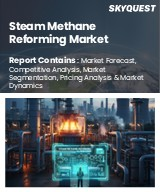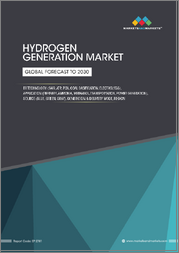
|
시장보고서
상품코드
1494740
수소 생성 시장 예측(-2030년) : 공급원별, 분배 모드별, 기술별, 용도별, 지역별 세계 분석Hydrogen Generation Market Forecasts to 2030 - Global Analysis By Source, Delivery Mode, Technology, Application and By Geography |
||||||
Stratistics MRC에 따르면, 세계 수소 생성 시장은 2024년 1,960억 7,000만 달러로 2030년까지 13.4%의 CAGR로 성장하여 4,169억 5,000만 달러에 달할 것으로 예상됩니다.
수소 제조는 청정 에너지원이나 산업용 원료로 사용하기 위해 다양한 방법으로 수소 가스를 제조하는 과정을 말합니다. 천연가스나 바이오매스를 수증기 개질하여 제품별로 이산화탄소와 함께 수소를 제조하는 방법도 있습니다. 또한, 태양전지나 풍력발전을 이용한 전기분해는 화석연료를 이용한 기술을 대체할 수 있는 지속가능한 수소 제조법으로 재생 가능한 방법으로 주목받고 있습니다.
IEA에 따르면 2022년 1월 현재 전 세계적으로 최소 50 개의 블루 수소 프로젝트가 진행 중이며 2030년까지 생산능력이 10배 이상 확대될 것으로 예상됩니다. Energy Institute Statistical Review of World Energy에 따르면에 따르면 2021년부터 2022년까지 석유 정제 능력은 0.5%의 성장률을 보였고, 지난 10년간의 연간 성장률은 0.7%였습니다.
청정 에너지에 대한 수요 증가
청정 에너지 솔루션에 대한 수요가 증가함에 따라 수소 생성 시장이 중요한 위치를 차지하고 있습니다. 수소는 다재다능함과 무공해 특성으로 인해 지속가능한 에너지 시스템으로의 전환에 있어 중요한 요소로 점점 더 많은 지지를 받고 있습니다. 전 세계 산업계와 정부가 탄소 배출량을 줄이기 위해 노력하고 있는 가운데, 수소는 운송, 산업, 발전 등의 분야에서 탈탄소화에 필수적인 요소로 자리 잡고 있습니다.
높은 초기 투자
수소의 안전한 저장과 운송을 위해 전기분해 및 수증기 메탄 개질을 위한 시설을 건설하고 수소를 안전하게 저장 및 운송하기 위해서는 막대한 자본 투자가 필요합니다. 이러한 경제적 부담은 잠재적 투자자와 이해관계자들이 시장 진입이나 기존 사업 확장을 주저하게 만드는 요인으로 작용합니다. 투자 수익과 규제 프레임워크를 둘러싼 불확실성은 자금 조달을 더욱 복잡하게 만듭니다. 그 결과, 많은 지역에서 수소 생성능력 확대가 지연되거나 한계에 직면하고 있으며, 이는 시장이 청정 에너지 솔루션으로 전환하는 데 있어 중요한 역할을 할 수 있는 잠재력을 저해하고 있습니다.
전해 기술의 발전
전기분해 기술의 발전은 보다 효율적이고 비용 효율적이며 지속가능한 수소 생성 방법을 제공함으로써 수소 생성 시장에 혁명을 불러일으키고 있습니다. 기존의 전기분해는 전기를 사용하여 물 분자를 수소와 산소로 분해합니다. 양성자교환막(PEM) 전기분해와 고체산화물 전해전지(SOEC)와 같은 최근의 기술 혁신은 수소 생성의 효율성과 확장성을 크게 향상시켰습니다. 예를 들어, PEM 전해질은 더 높은 압력과 온도에서 작동하기 때문에 반응 속도가 빨라지고 에너지 소비가 적습니다.
밸류체인에서의 에너지 손실
수소 생성 시장의 성장에 있어 가치사슬에서의 에너지 손실은 수소 생성 시장의 성장에 큰 도전이 되고 있습니다. 수소 생성에는 추출, 전기분해, 압축, 운송 등 여러 단계가 있으며, 각 단계마다 에너지 손실이 발생하기 쉽습니다. 예를 들어, 수증기 메탄 개질과 같은 전통적인 방법은 원료 전환 및 운송 과정에서 에너지 손실이 발생합니다. 마찬가지로 전기분해는 녹색 수소 생성에 유망하지만 발전과 전환 과정에서 효율 손실이 발생합니다. 이러한 손실은 수소 생성의 전체 효율을 떨어뜨릴 뿐만 아니라 비용을 상승시켜 화석 연료에 비해 수소의 경쟁력을 떨어뜨립니다.
COVID-19의 영향:
초기에 시장은 바이러스 확산을 막기 위해 시행된 봉쇄 및 제한 조치로 인해 공급망과 제조 공정에 혼란을 겪었습니다. 이로 인해 소규모 사업자와 고객들 사이에서 수요가 감소하고 자금 유동성이 악화되면서 세계 수소 생성 시장에 영향을 미쳤습니다. 그러나 COVID-19는 청정 에너지원의 중요성을 부각시켰고, 지속가능한 대체 에너지로서 수소에 대한 관심과 투자를 증가시켰습니다.
예측 기간 동안 바이오매스 분야가 가장 큰 비중을 차지할 것으로 예상됩니다.
바이오매스 분야는 지속가능하고 재생 가능한 수소 생성원을 제공함으로써 예측 기간 동안 가장 큰 성장세를 보일 것으로 예상됩니다. 농업 잔재, 임업 폐기물, 유기성 도시 고형 폐기물과 같은 유기물에서 얻은 바이오매스는 가스화, 열분해, 발효와 같은 다양한 열화학 및 생화학 공정을 통해 수소로 전환될 수 있습니다. 이러한 접근 방식은 화석연료를 대체할 수 있는 신뢰할 수 있는 대체 연료를 제공할 뿐만 아니라 온실 가스 배출을 줄이는 데 도움이 되어 환경 문제에도 대응할 수 있습니다.
부분 산화 부문은 예측 기간 동안 가장 높은 CAGR을 기록할 것으로 예상됩니다.
부분 산화 분야는 예측 기간 동안 가장 높은 CAGR을 보일 것으로 예상됩니다. 부분 산화는 일반적으로 촉매의 존재하에 탄화수소를 산소와 반응시켜 수소 가스를 생성합니다. 이 공정은 높은 변환 효율, 원료 선택의 다양성, 수증기 메탄 개질과 같은 기존 방법에 비해 상대적으로 낮은 운영 비용과 같은 몇 가지 장점이 있습니다. 또한 POX는 천연가스, 석탄, 바이오매스 등 다양한 원료를 사용할 수 있기 때문에 지리적, 경제적 배경의 차이에 적응할 수 있습니다.
가장 큰 점유율을 가진 지역:
녹색 수소 생성은 풍력이나 태양광과 같은 재생에너지를 이용하여 탄소 배출을 크게 줄일 수 있습니다. 이러한 발전은 환경 문제를 해결할 뿐만 아니라 에너지 믹스를 다양화함으로써 에너지 독립과 안보를 촉진할 수 있습니다. 또한, 그린수소의 확장성과 다재다능함은 지역 내 운송 및 발전 등 다양한 부문의 탈탄소화를 위한 유망한 솔루션이 될 수 있습니다.
CAGR이 가장 높은 지역:
유럽 지역은 예측 기간 동안 수익성 있는 성장을 이룰 것으로 보입니다. 엄격한 배출량 목표와 탄소 중립 추구로 인해 각국 정부가 수소 기술을 지역적으로 도입할 수 있는 인센티브를 제공하고 있습니다. 유럽 그린딜과 각국의 수소 전략과 같은 정책은 연구개발과 인프라 구축에 자금을 할당하여 기술 혁신과 시장 성장을 촉진하고 있습니다. 또한, 규제 프레임워크는 투자자들에게 확실성을 제공하고, 지역 내 수소 생성과 유통을 확대하기 위해 민간 부문의 참여를 장려하고 있습니다.
무료 커스터마이징 서비스
이 보고서를 구독하는 고객은 다음과 같은 무료 맞춤화 옵션 중 하나를 사용할 수 있습니다.
- 기업 개요
- 추가 시장 기업 종합 프로파일링(최대 3개사까지)
- 주요 기업 SWOT 분석(최대 3개사)
- 지역 세분화
- 고객의 관심에 따른 주요 국가별 시장 추정치, 예측, CAGR(주: 타당성 검토에 따른)
- 경쟁사 벤치마킹
- 제품 포트폴리오, 지리적 입지, 전략적 제휴를 기반으로 한 주요 기업 벤치마킹
목차
제1장 주요 요약
제2장 서문
- 개요
- 이해관계자
- 조사 범위
- 조사 방법
- 데이터 마이닝
- 데이터 분석
- 데이터 검증
- 조사 접근법
- 조사 정보 출처
- 1차 조사 정보 출처
- 2차 조사 정보 출처
- 가정
제3장 시장 동향 분석
- 성장 촉진요인
- 성장 억제요인
- 기회
- 위협
- 기술 분석
- 용도 분석
- 신흥 시장
- COVID-19의 영향
제4장 Porter's Five Forces 분석
- 공급 기업의 교섭력
- 구매자의 교섭력
- 대체품의 위협
- 신규 참여업체의 위협
- 경쟁 기업 간의 경쟁 관계
제5장 세계의 수소 생성 시장 : 공급원별
- 석탄
- 천연가스
- 바이오매스
- 기타 공급원
제6장 세계의 수소 생성 시장 : 분배 모드별
- 자사용
- 판매용
- 기타 분배 모드
제7장 세계의 수소 생성 시장 : 기술별
- 부분 산화
- 수증기 메탄 개질
- 전해
- 기타 기술
제8장 세계의 수소 생성 시장 : 용도별
- 발전
- 정유
- 수송
- 기타 용도
제9장 세계의 수소 생성 시장 : 지역별
- 북미
- 미국
- 캐나다
- 멕시코
- 유럽
- 독일
- 영국
- 이탈리아
- 프랑스
- 스페인
- 기타 유럽
- 아시아태평양
- 일본
- 중국
- 인도
- 호주
- 뉴질랜드
- 한국
- 기타 아시아태평양
- 남미
- 아르헨티나
- 브라질
- 칠레
- 기타 남미
- 중동 및 아프리카
- 사우디아라비아
- 아랍에미리트
- 카타르
- 남아프리카공화국
- 기타 중동 및 아프리카
제10장 주요 발전
- 계약, 파트너십, 협업, 합작투자
- 인수와 합병
- 신제품 발매
- 사업 확대
- 기타 주요 전략
제11장 기업 개요
- Air Liquide S.A.
- Ballard Power Systems
- Cummins Inc
- Fuelcell Energy
- Hiringa Energy Limited
- ITM Power
- Plug Power
- Praxair Inc
- Siemens
According to Stratistics MRC, the Global Hydrogen Generation Market is accounted for $196.07 billion in 2024 and is expected to reach $416.95 billion by 2030 growing at a CAGR of 13.4% during the forecast period. It refers to the process of producing hydrogen gas through various methods, typically for use as a clean energy source or industrial feedstock. Another approach involves steam reforming of natural gas or biomass, which produces hydrogen along with carbon dioxide as a byproduct. Additionally, solar or wind-powered electrolysis is gaining traction as a renewable method of hydrogen production, offering a sustainable alternative to fossil fuel-based techniques.
According to IEA, in January 2022, there were at least 50 blue hydrogen projects in the works around the world, with capacity expected to grow more than tenfold by 2030. According to the Energy Institute Statistical Review of World Energy, the oil refining capacity witnessed a growth rate of 0.5% between 2021 and 2022, whereas the annual growth rate in the last decade was 0.7%.
Market Dynamics:
Driver:
Increasing demand for clean energy
The growing demand for clean energy solutions has propelled the hydrogen generation market into a prominent position. Hydrogen, renowned for its versatility and zero-emission properties, is increasingly favored as a key component in the transition towards sustainable energy systems. As industries and governments worldwide commit to reducing carbon footprints, hydrogen emerges as a vital player in decarbonizing sectors such as transportation, industry, and power generation.
Restraint:
High initial investment
Building facilities for electrolysis or steam methane reforming, as well as ensuring safe storage and transportation of hydrogen, demands substantial capital outlay. This financial burden often dissuades potential investors and stakeholders from entering the market or expanding existing operations. The uncertainty surrounding returns on investment and regulatory frameworks further complicates financing arrangements. Consequently, many regions face delays or limitations in scaling up hydrogen production capacity, hindering the market's potential to become a prominent player in the transition towards cleaner energy solutions.
Opportunity:
Advancements in electrolysis technologies
Advancements in electrolysis technologies are revolutionizing the hydrogen generation market by offering more efficient, cost-effective, and sustainable methods for producing hydrogen. Traditional electrolysis involves splitting water molecules into hydrogen and oxygen using electricity. Recent innovations such as proton exchange membrane (PEM) electrolysis and solid oxide electrolysis cells (SOEC) have significantly improved the efficiency and scalability of hydrogen production. PEM electrolysis, for instance, operates at higher pressures and temperatures, resulting in faster reaction rates and lower energy consumption.
Threat:
Energy loss in value chain
Energy loss in the value chain poses a significant challenge to the growth of the hydrogen generation market. Hydrogen production involves several stages, from extraction or electrolysis to compression and transportation, each prone to energy losses. For instance, conventional methods like steam methane reforming suffer from energy loss during conversion and transportation of feedstocks. Similarly, electrolysis, though promising for green hydrogen production, faces efficiency losses during electricity generation and conversion. These losses not only decrease the overall efficiency of hydrogen production but also increase costs, making hydrogen less competitive against fossil fuels.
Covid-19 Impact:
Initially, the market experienced disruptions in supply chains and manufacturing processes due to lockdowns and restrictions imposed to curb the spread of the virus. The pandemic has therefore had an impact on the global market for hydrogen generation due to decreased demand and cash-deficit difficulties among small operators and clients. However, the pandemic also highlighted the importance of clean energy sources, leading to increased interest and investments in hydrogen as a sustainable alternative.
The Biomass segment is expected to be the largest during the forecast period
Biomass segment is expected to be the largest during the forecast period by offering a sustainable and renewable source for hydrogen production. Biomass, derived from organic materials such as agricultural residues, forestry waste, and organic municipal solid waste, can be converted into hydrogen through various thermochemical and biochemical processes like gasification, pyrolysis, and fermentation. This approach not only provides a reliable alternative to fossil fuels but also helps in reducing greenhouse gas emissions, thus addressing environmental concerns.
The Partial Oxidation segment is expected to have the highest CAGR during the forecast period
Partial Oxidation segment is expected to have the highest CAGR during the forecast period. Partial Oxidation involves reacting hydrocarbons with oxygen, typically in the presence of a catalyst, to generate hydrogen gas. This process offers several advantages, including high conversion efficiency, versatility in feedstock selection, and relatively low operational costs compared to traditional methods like steam methane reforming. Moreover, POX can utilize a variety of feedstocks such as natural gas, coal, or biomass, making it adaptable to different geographical and economic contexts.
Region with largest share:
By harnessing renewable energy sources such as wind and solar power, green hydrogen production significantly reduces carbon emissions, aligning with the region's ambitious climate goals, North America region commanded the largest market share during the projection period. This advancement not only addresses environmental concerns but also fosters energy independence and security by diversifying the energy mix. Moreover, the scalability and versatility of green hydrogen make it a promising solution for decarbonizing various sectors, including transportation and power generation across the region.
Region with highest CAGR:
Europe region is poised to witness profitable growth over the extrapolated period. Stricter emissions targets and the pursuit of carbon neutrality are driving governments to incentivize the regional adoption of hydrogen technologies. Policies such as the European Green Deal and national hydrogen strategies allocate funding for research, development and infrastructure, fostering innovation and market growth. Additionally, regulatory frameworks provide certainty for investors, encouraging private sector involvement in scaling up hydrogen production and distribution across the region.
Key players in the market
Some of the key players in Hydrogen Generation market include Air Liquide S.A., Ballard Power Systems, Cummins Inc, Fuelcell Energy, Hiringa Energy Limited, ITM Power, Plug Power, Praxair Inc and Siemens.
Key Developments:
In October 2023, H2B2, a technology company with a portfolio in Hydrogen production systems, unveiled the green hydrogen plant, which is expected to become operational in North America, the SoHyCal facility located in Fresno, California, United States. The project envisages 100 percent clean hydrogen production using PEM technology.
In October 2023, Hygenco Green Energies announced its plans to operate and construct a cent percent green H2 gas plant in Maharashtra, India. The company also plans to supply green hydrogen and green oxygen to Sterlite Technologies Ltd. This is expected to become one of the first hydrogen Generation Plants in Maharashtra.
In May 2023, the Tokyo Tech InfoSyEnergy Research and Education Consortium, in collaboration with the Tokyo Tech Academy of Energy and Informatics, introduced a fuel cell capable of producing electricity using a combination of hydrogen and hydrogen derived from waste plastic materials.
In February 2023, the leading Indian oil company, Indian Oil Corporation (IOC), embarked on a green transformation strategy worth INR 2 trillion, with the aim of achieving net-zero emissions from its operational activities by 2046. As part of this initiative, Indian Oil Corporation plans to establish green hydrogen facilities at all of its refineries.
Sources Covered:
- Coal
- Natural Gas
- Biomass
- Other Sources
Delivery Modes Covered:
- Captive
- Merchant
- Other Delivery Modes
Technologies Covered:
- Partial Oxidation
- Steam Methane Reforming
- Electrolysis
- Other Technologies
Applications Covered:
- Power Generation
- Petroleum Refining
- Transportation
- Other Applications
Regions Covered:
- North America
- US
- Canada
- Mexico
- Europe
- Germany
- UK
- Italy
- France
- Spain
- Rest of Europe
- Asia Pacific
- Japan
- China
- India
- Australia
- New Zealand
- South Korea
- Rest of Asia Pacific
- South America
- Argentina
- Brazil
- Chile
- Rest of South America
- Middle East & Africa
- Saudi Arabia
- UAE
- Qatar
- South Africa
- Rest of Middle East & Africa
What our report offers:
- Market share assessments for the regional and country-level segments
- Strategic recommendations for the new entrants
- Covers Market data for the years 2022, 2023, 2024, 2026, and 2030
- Market Trends (Drivers, Constraints, Opportunities, Threats, Challenges, Investment Opportunities, and recommendations)
- Strategic recommendations in key business segments based on the market estimations
- Competitive landscaping mapping the key common trends
- Company profiling with detailed strategies, financials, and recent developments
- Supply chain trends mapping the latest technological advancements
Free Customization Offerings:
All the customers of this report will be entitled to receive one of the following free customization options:
- Company Profiling
- Comprehensive profiling of additional market players (up to 3)
- SWOT Analysis of key players (up to 3)
- Regional Segmentation
- Market estimations, Forecasts and CAGR of any prominent country as per the client's interest (Note: Depends on feasibility check)
- Competitive Benchmarking
- Benchmarking of key players based on product portfolio, geographical presence, and strategic alliances
Table of Contents
1 Executive Summary
2 Preface
- 2.1 Abstract
- 2.2 Stake Holders
- 2.3 Research Scope
- 2.4 Research Methodology
- 2.4.1 Data Mining
- 2.4.2 Data Analysis
- 2.4.3 Data Validation
- 2.4.4 Research Approach
- 2.5 Research Sources
- 2.5.1 Primary Research Sources
- 2.5.2 Secondary Research Sources
- 2.5.3 Assumptions
3 Market Trend Analysis
- 3.1 Introduction
- 3.2 Drivers
- 3.3 Restraints
- 3.4 Opportunities
- 3.5 Threats
- 3.6 Technology Analysis
- 3.7 Application Analysis
- 3.8 Emerging Markets
- 3.9 Impact of Covid-19
4 Porters Five Force Analysis
- 4.1 Bargaining power of suppliers
- 4.2 Bargaining power of buyers
- 4.3 Threat of substitutes
- 4.4 Threat of new entrants
- 4.5 Competitive rivalry
5 Global Hydrogen Generation Market, By Source
- 5.1 Introduction
- 5.2 Coal
- 5.3 Natural Gas
- 5.4 Biomass
- 5.5 Other Sources
6 Global Hydrogen Generation Market, By Delivery Mode
- 6.1 Introduction
- 6.2 Captive
- 6.3 Merchant
- 6.4 Other Delivery Modes
7 Global Hydrogen Generation Market, By Technology
- 7.1 Introduction
- 7.2 Partial Oxidation
- 7.3 Steam Methane Reforming
- 7.4 Electrolysis
- 7.5 Other Technologies
8 Global Hydrogen Generation Market, By Application
- 8.1 Introduction
- 8.2 Power Generation
- 8.3 Petroleum Refining
- 8.4 Transportation
- 8.5 Other Applications
9 Global Hydrogen Generation Market, By Geography
- 9.1 Introduction
- 9.2 North America
- 9.2.1 US
- 9.2.2 Canada
- 9.2.3 Mexico
- 9.3 Europe
- 9.3.1 Germany
- 9.3.2 UK
- 9.3.3 Italy
- 9.3.4 France
- 9.3.5 Spain
- 9.3.6 Rest of Europe
- 9.4 Asia Pacific
- 9.4.1 Japan
- 9.4.2 China
- 9.4.3 India
- 9.4.4 Australia
- 9.4.5 New Zealand
- 9.4.6 South Korea
- 9.4.7 Rest of Asia Pacific
- 9.5 South America
- 9.5.1 Argentina
- 9.5.2 Brazil
- 9.5.3 Chile
- 9.5.4 Rest of South America
- 9.6 Middle East & Africa
- 9.6.1 Saudi Arabia
- 9.6.2 UAE
- 9.6.3 Qatar
- 9.6.4 South Africa
- 9.6.5 Rest of Middle East & Africa
10 Key Developments
- 10.1 Agreements, Partnerships, Collaborations and Joint Ventures
- 10.2 Acquisitions & Mergers
- 10.3 New Product Launch
- 10.4 Expansions
- 10.5 Other Key Strategies
11 Company Profiling
- 11.1 Air Liquide S.A.
- 11.2 Ballard Power Systems
- 11.3 Cummins Inc
- 11.4 Fuelcell Energy
- 11.5 Hiringa Energy Limited
- 11.6 ITM Power
- 11.7 Plug Power
- 11.8 Praxair Inc
- 11.9 Siemens



















